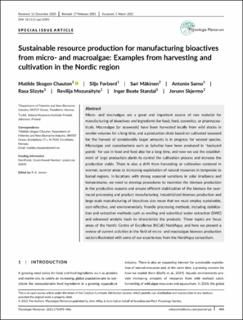| dc.contributor.author | Chauton, Matilde Skogen | |
| dc.contributor.author | Forbord, Silje | |
| dc.contributor.author | Makinen, Sari | |
| dc.contributor.author | Sarno, Antonio | |
| dc.contributor.author | Slizyte, Rasa | |
| dc.contributor.author | Mozuraityte, Revilija | |
| dc.contributor.author | Standal, Inger Beate | |
| dc.contributor.author | Skjermo, Jorunn | |
| dc.date.accessioned | 2021-12-06T14:29:10Z | |
| dc.date.available | 2021-12-06T14:29:10Z | |
| dc.date.created | 2021-04-07T11:27:28Z | |
| dc.date.issued | 2021 | |
| dc.identifier.citation | Physiologia Plantarum : An International Journal for Plant Biology. 2021, 1-12. | en_US |
| dc.identifier.issn | 0031-9317 | |
| dc.identifier.uri | https://hdl.handle.net/11250/2832997 | |
| dc.description.abstract | Micro- and macroalgae are a great and important source of raw material for manufacturing of bioactives and ingredients for food, feed, cosmetics, or pharmaceuticals. Macroalgae (or seaweeds) have been harvested locally from wild stocks in smaller volumes for a long time, and a production chain based on cultivated seaweed for the harvest of considerably larger amounts is in progress for several species. Microalgae and cyanobacteria such as Spirulina have been produced in “backyard ponds” for use in food and feed also for a long time, and now we see the establishment of large production plants to control the cultivation process and increase the production yields. There is also a shift from harvesting or cultivation centered in warmer, sunnier areas to increasing exploitation of natural resources in temperate to boreal regions. In locations with strong seasonal variations in solar irradiance and temperatures, we need to develop procedures to maximize the biomass production in the productive seasons and ensure efficient stabilization of the biomass for year-round processing and product manufacturing. Industrialized biomass production and large-scale manufacturing of bioactives also mean that we must employ sustainable, cost-effective, and environmentally friendly processing methods, including stabilization and extraction methods such as ensiling and subcritical water extraction (SWE) and advanced analytic tools to characterize the products. These topics are focus areas of the Nordic Centre of Excellence (NCoE) NordAqua, and here we present a review of current activities in the field of micro- and macroalgae biomass production sectors illustrated with some of our experiences from the NordAqua consortium. | en_US |
| dc.language.iso | eng | en_US |
| dc.publisher | Wiley | en_US |
| dc.rights | Navngivelse 4.0 Internasjonal | * |
| dc.rights.uri | http://creativecommons.org/licenses/by/4.0/deed.no | * |
| dc.title | Sustainable resource production for manufacturing bioactives from micro- and macroalgae: Examples from harvesting and cultivation in the Nordic region | en_US |
| dc.type | Peer reviewed | en_US |
| dc.type | Journal article | en_US |
| dc.description.version | publishedVersion | en_US |
| dc.rights.holder | © 2021 The Authors. Physiologia Plantarum published by John Wiley & Sons Ltd on behalf of Scandinavian Plant Physiology Society. | en_US |
| dc.source.pagenumber | 495-506 | en_US |
| dc.source.volume | 173 | en_US |
| dc.source.journal | Physiologia Plantarum : An International Journal for Plant Biology | en_US |
| dc.source.issue | 2 | en_US |
| dc.identifier.doi | 10.1111/ppl.13391 | |
| dc.identifier.cristin | 1902645 | |
| dc.relation.project | Nordforsk: 82845 | en_US |
| dc.relation.project | Norges forskningsråd: 294946 | en_US |
| cristin.ispublished | true | |
| cristin.fulltext | original | |
| cristin.qualitycode | 1 | |

